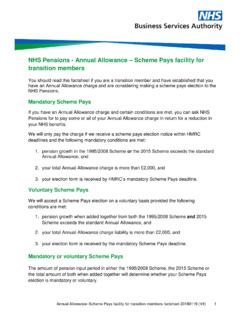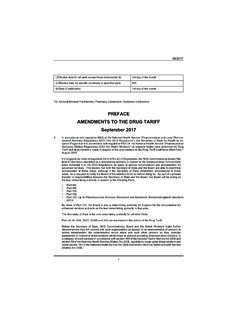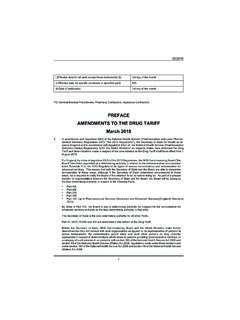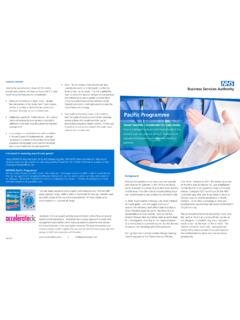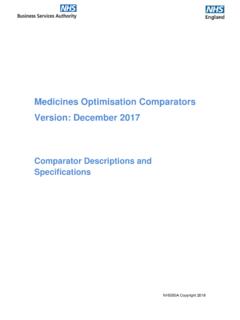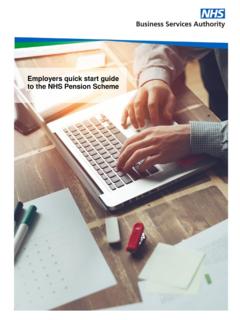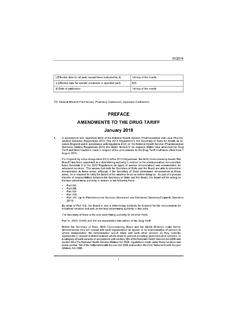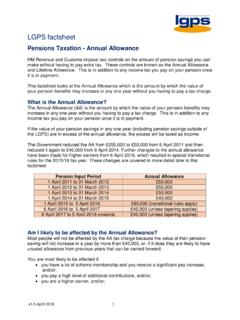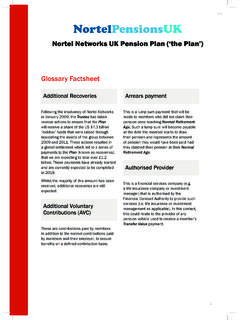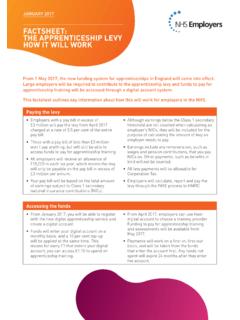Transcription of NHS Pensions factsheet template V1 - NHSBSA
1 Fixed Protection 2012 and Benefit Accrual (01/2014) (V2) 1 NHS Pensions - lifetime allowance : Fixed Protection 2012 and Benefit Accrual in the NHS pension Scheme When the standard lifetime allowance (LTA) reduced from to on 6 April 2012, HM Revenue & Customs (HMRC) recognised that some members may have already built up total pension savings of more than or were planning to do so in the belief that the standard LTA would not reduce from the 2011/12 level; and because of this they introduced fixed protection. Members who have a certificate of fixed protection must test for Benefit Accrual.
2 When to test for benefit accrual It is important to note that there is no legislative requirement on NHS Pensions and as such we will not test benefits for benefit accrual. It is the member s responsibility to test for benefit accrual, which can occur at any time during a tax year. The member must test for benefit accrual with sufficient regularity to ensure they meet their obligation see note 2 of the fixed protection certificate. If benefit accrual has occurred members must inform HMRC of this within 90 days of it occurring. HMRC can impose fines on late notifications, these are an initial fine of up to 300 and a further 60 for each day the notification is late.
3 Benefit Accrual From 6 April 2012, benefit accrual will occur and fixed protection lost if the capital value of the NHS benefits increase by more than the relevant percentage at any time during a tax year. The member will lose their fixed protection at the date the relevant percentage was exceeded. The capital value of NHS benefits is: 20 x pension + lump sum The pension and lump sum are based on the benefits the member would have received if they had reached normal retirement age on that day. These benefits take no account of any enhancements due to ill-health or actuarial reductions due to early retirement.
4 They do include any additional purchase, any doubled years due to Mental Health Officer status. The relevant percentage in the NHS pension Scheme is the percentage by which the Consumer Prices Index (CPI) increased in the year ending in September of the previous tax year. If there is no increase, or a fall in CPI in this period, then the relevant percentage rate is nil. Fixed Protection 2012 and Benefit Accrual (01/2014) (V2) 2 When carrying out a benefit accrual test during a tax year, the relevant percentage to be used is always by reference to the annual rate, rather than a proportion of it.
5 For tax year 2012/13 the relevant percentage is and applies to increases in pension rights occurring in this tax year. How to test for benefit accrual To test for benefit accrual in the NHS pension Scheme the member has to establish the capital value of their benefits payable on 6 April 2012 (and each subsequent year whilst they retain fixed protection). They must then calculate the growth of their benefits to confirm if there is benefit accrual. Where benefit accrual occurs they must establish the exact date that accrual occurred. Example 1: On 5 April 2012 a John who works full time has 42 years membership and pensionable pay of 90,967, giving him a pension of 47, , a lump sum of 143, and a capital value of 1,098, On 6 April 2012 John s pensionable pay rises to 95,333.
6 At this point he can make a forecast that at 5 April 2013, with growth in membership of 1 year to 43 years, he will have potential benefits of a pension of 51, , a lump sum of 153, and a capital value of 1,178, The maximum growth allowed before benefit accrual occurs is the capital value at the beginning of the year plus CPI from the previous September: 1,098, + = 1,155, As this figure is lower than the capital value John thinks he will have on 5 April 2013 he knows that benefit accrual will occur at some point during the tax-year 2012/13. John knows he must inform HMRC within 90 days of benefit accrual occurring and must decide on the frequency of when to test for benefit accrual in order to establish the exact date it occurs.
7 John decides to test for benefit accrual at the end of each calendar month. From 6 April 2012 to 30 November 2012 his membership has increased to 42 years 239 days while his pensionable pay has risen to ( 90,967 x 126 / 365 + 95,333 x 239 / 365) giving him a pension of 50, , a lump sum of 150, with a capital value of 1,150, benefit accrual has not yet occurred. From 6 April 2012 to 30 December 2012 his membership has increased to 42 years 270 days while his pensionable pay has risen to 94, ( 90,967 x 95 / 365 + 95,333 x 270 / 365) giving him a pension of 50, , a lump sum of 150, with a capital value of 1,157, benefit accrual has occurred.
8 Fixed Protection 2012 and Benefit Accrual (01/2014) (V2) 3 John then works out the date benefit accrual actually occurs on 23 December 2012. Practitioner members must establish the value of their benefits and their capital value on 5 April 2012, using dynamised pay and membership, including any salaried hospital/community pensionable membership, and any additional purchases to that date. Again this capital value would be increased by the appropriate CPI amount ( for the tax-year 2012/13) to give the amount benefits can grow before benefit accrual occurs. To establish the capital value of their benefits at any particular date, the member would need to add the appropriate monthly dynamising figure and adjust for hospital/community pensionable membership.
9 Members subject to the earnings cap An active scheme member whose benefits are solely based on pay limited to the earnings cap will lose fixed protection. This is because the earnings cap is increased by RPI and fixed protection only allows CPI RPI (of ) was greater than CPI ( ) in September 2011. However, active NHS member s benefits may be based on a combination of both capped and uncapped earnings dependant upon the individual s circumstances. Example 2: Jenny joined the NHSPS on 6 April 1990 and has 22 years membership at 5 April 2012, of which 17 years 360 days are subject to an earnings cap, the cap for 2011/12 was 129,600.
10 For her membership not subject to the earnings cap her pensionable pay was 146,000. This gives her a pension of 36, , a lump sum of 109, and a capital value of 838, On the 6 April 2012 Jenny s pensionable pay does not increase, but the earnings cap increased to 137,400. With growth in membership of 1 year on 5 April 2013 she will have a potential pension of 40, , lump sum of 120, and a capital value of 920, The maximum growth allowed before benefit accrual occurs is 882, This is the capital value at the beginning of the year plus CPI from the previous September: 838, + = 882, This figure is lower than the potential capital value Jenny thinks she will have on 5 April 2013 she knows that benefit accrual will occur during the tax-year 2012/13.
